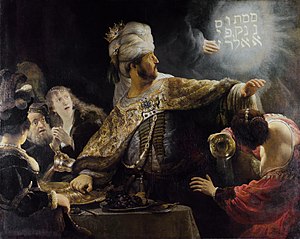The banquet of Belshazzar

|
| The banquet of Belshazzar |
|---|
| Rembrandt van Rijn , 1635 |
| Oil on canvas |
| 167 × 209 cm |
| National Gallery (London) |
The Feast of Belshazzar is a going back to the Bible story of the Babylonian ruler Belshazzar , the mysterious handwriting on the wall, the writing on the wall , his near death and the destruction prophesied his kingdom. The motif has been taken up by various painters, the painting on display here was painted by Rembrandt around 1635 . The painting is signed “Rembrandt f. 163. “, the last digit is illegible. The 1.67 x 2.09 meter picture, painted on canvas, belongs to the collection of the National Gallery in London .
background
The story about Belshazzar comes from the Old Testament of the Bible (The Feast of Belshazzar, Dan 5 ). Belshazzar celebrated a lavish festival using vessels that his father had stolen from the temple in Jerusalem when a ghostly writing appeared on the wall of his palace. He immediately summoned his scribes, but they proved unable to decipher the text. Then the prophet Daniel was brought about. He read: “ Mene mene tekel u-pharsin ” (Daniel 5:25), and interpreted this as a prophecy of the downfall of the kingdom of Belshazzar. That same night, Belshazzar was slain by his servants.
The literal translation of Mene mene tekel u-pharsin from Aramaic is unclear. Daniel interprets the oracle with the help of similar sounding Aramaic verbs: "counted, weighed and divided". Daniel interprets as follows:
- God has counted and ended your kingship
- You have been weighed and found too light
- Your kingdom will be divided and given to the Medes and Persians .
Historical reference
The word play mene mene tekel u-pharsin is most likely a rebus and is a derivative of the Akkadian words manû šiqlu parsu , which were used to denote weight units . Against this background, it is clear why none of those present could explain the meaning of these words, even though the terms belonged to everyday language. The author of the Daniel book turns this into a play on words in the Aramaic language , the literal translation of which remains unclear today as it was then.
Daniel is assigned by the editors of the Daniel book the role of an Entu priestess who performed the omen interpretation in the Babylonian Empire. The biblical name Belšazar, son of Nebuchadnezzar is historically refuted, since Nabu-na'id was the father of Belšazar. Nabu-na'id ruled for another three years after his return, if only as a kind of vassal king. Belšazar was the deputy of King Nabu-na'id up to this point, as he was not in Babylon at that time.
It cannot be ruled out that there is a historical reference and that Belšazar was actually killed by the Marduk priesthood . The last time he is named as a deputy in the 13th year of the Nabu-na'id , whom he has represented since the 4th year of government. After the Babylonian king returned from Tayma , Belšazar's name was no longer mentioned in other documents. In the Nabu-na'id chronicles, however, a premature death of his son is not recorded. In this context it is also significant that the descendants of the Babylonian king were not prophesied of any subsequent kingship .
Rembrandt painting
In his painting Rembrandt captured the moment in which the crowd of guests saw the mysterious handwriting on the wall. The frightened faces of those present and the horror of Belshazzar are reflected in the representation. One can see from the king that he cannot do anything with the lettering, but nevertheless has the unmistakable feeling that this cannot mean anything good. While the presentation of the mysterious writing was often omitted in the representations of other painters - no one knew exactly how to depict the menetekel, Rembrandt accepted the challenge: He presumably let Rabbi Menasse ben Israel , whom he portrayed in 1636, advised on the representation of the Hebrew language and put a lettering in Hebrew letters on the wall, which can be read from right to left and especially from top to bottom.
The painting had been in the possession of the Earl of Derby since 1736 and for a long time was only known in England. While it was little appreciated in the 19th century, it did not develop into one of Rembrandt's most famous paintings until the mid-20th century. In 1964 the National Gallery in London acquired it. It received more attention there and was the third most popular image licensed for commercial use in 2014.
Ballad Heines
In his ballad Belsatzar (1820) Heinrich Heine describes the biblical story in a slightly modified form.
literature
- Rose-Marie and Rainer Hagen: Image surveys - masterpieces in detail , Benedikt Taschen Verlag, Cologne 1994
Individual evidence
- ↑ a b Dietz-Otto Edzard (Hrsg.): Reallexikon der Assyriologie and Near Eastern Archeology . (RLA) Volume 2: Ber – Ezur and supplements. de Gruyter, Berlin 1978, ISBN 3-11-004450-1 , p. 118.
- ↑ David Clines, Elke Blumenthal: Wisdom in Israel: Contributions to the Symposium “The Old Testament and Modern Culture” on the occasion of Gerhard von Rad's 100th birthday (1901–1971), Heidelberg, 18. – 21. October 2001 , Lit, Münster 2003, p. 43.
- ↑ Sebastian Dohe: Weighed and found too light? The reception of Rembrandt's "Banquet of Belshazzar" . In: Justus Lange / Sebastian Dohe / Anne Harmssen (eds.): Mene, mene tekel. The banquet of Belshazzar in Dutch art . Michael Imhof Verlag, Petersberg 2014, ISBN 978-3-7319-0153-2 , p. 61-81 .